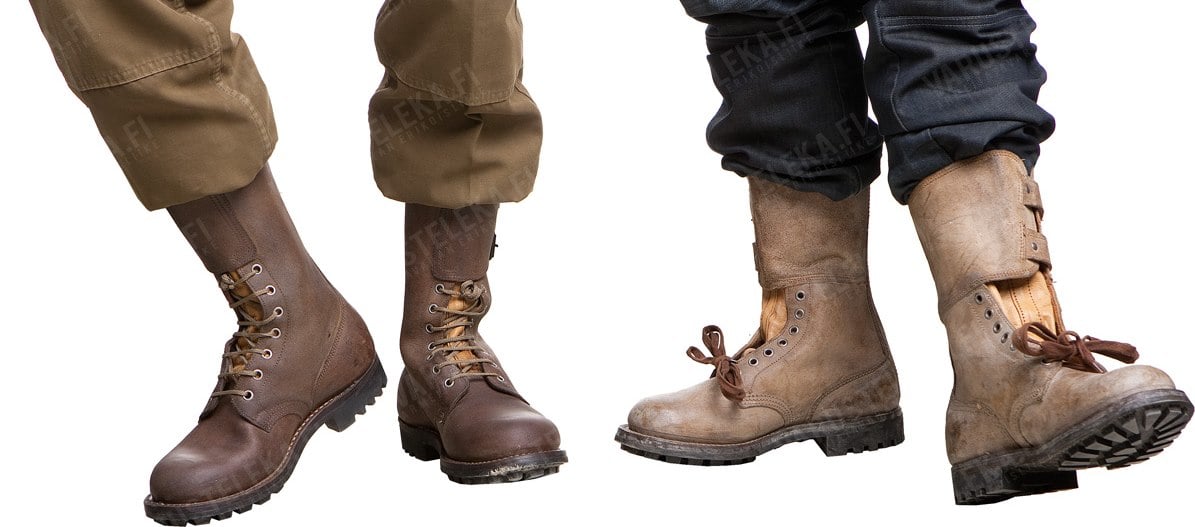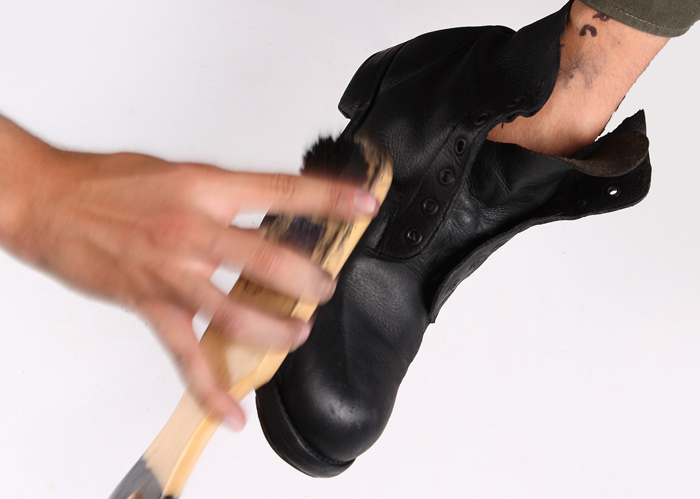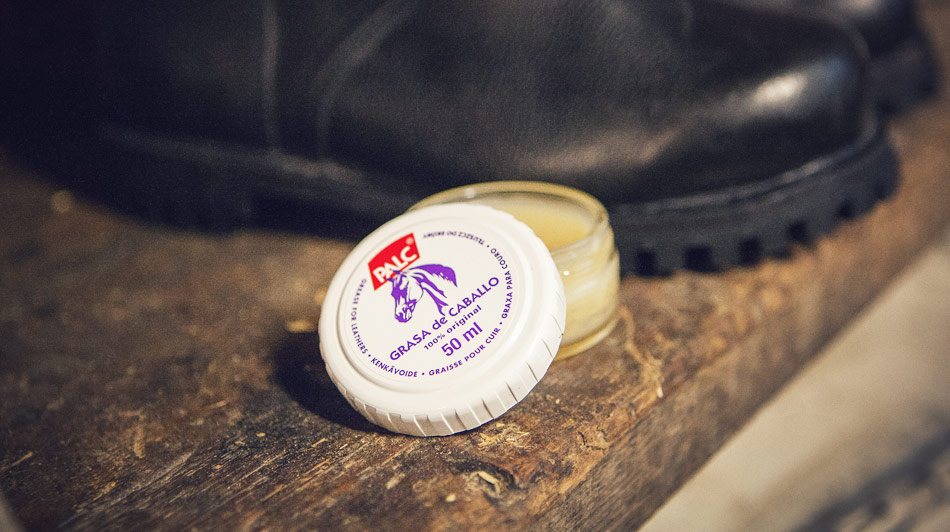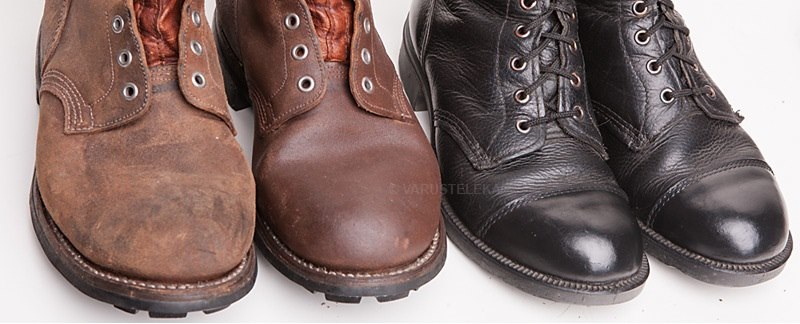
Rights Reserved - Free Access.
This digital object is protected by copyright and/or related rights. This digital object is accessible without charge, but its use is subject to written permission.
Unless expressly stated otherwise in the licensing conditions, you are free to make any of the acts permitted by your national copyright and related rights act, including browsing, printing and making a copy for your own personal purposes.
All other acts of reproduction and communication to the public are subject to the licensing conditions attached to the digital object.
ARMY BOOTS OF THE WORLD. REVIEWS
Important notice: we do not sell any boots! The prices are given for information purposes only!
The Care for Your Shoes and Boots, Explained by Varusteleka
Proper shoe care is vitally necessary to prolong the service life of your boots or shoes. This article covers how to take care of footwear sold by us, and generally army and outdoor boots. Fancy dancing shoes and fashion items are not included, to keep it as simple and short as possible.
Instead of just saying it's so, we try to be transparent about why certain things are advised for or against.
Taking good care of your boots is one of the most therapeutic things you can do with your pants on. Or you can take your pants off when brushing your shoes, if you fancy.
Your shoes and boots will live a happy life when you use and maintain them correctly from the start. That will be the appropriate place to begin, then we will cover the actual maintenance process from cleaning and treatments to finishing, and finally, a few words on substances. Shoe care substances, that is.
Prevention of Trouble
A drop of prevention beats a bucket of attempts to salvage neglected boots. Consider the intended use before deciding which shoes to buy: for mostly dry environments, prioritize breathability. If you intend to stand guard ankle-deep in water, rubber boots are the better choice even though many leather boots are nominally waterproof.
Socks and Insoles
Socks and insoles are as much a part of your footwear as the boots themselves. Not only do they affect insulation and moisture control, but the thickness and shape of the insole have a noticeable impact on the fit of the boot.
Forget cotton tennis socks right away and choose something with a blend of Merino wool and synthetic materials for durability and moisture control. Carry spare socks with you and rotate them on breaks to improve your comfort level and reduce the accumulation of moisture in the boot.
Insoles are available with various insulation and shock-absorbing properties. A flat insole can be stacked below a shaped one to improve fit around a narrow foot. As with socks, it's advisable to rotate insoles periodically to have something clean and dry below your feet.
Walking in and Pre-Treatment
Leathers are grainy natural materials with fibers that stretch and settle as the leather is manipulated through use. Dry leather has more friction between the fibers which makes the material stiff and prone to break. Leather requires oils and fats for this very reason: to keep it both strong and comfortable, or supple as they say.
New boots are most likely not dry as tinder but can benefit from some treatment to speed up the break-in process. Take the boots out for walks and experiment with different sock and insole combinations before settling. This is where it takes two to tango: your feet adapt to the boots and the boots form to fit your feet better.
Pre-treatment is the same as a regular treatment, you just do it up front and more often in the beginning.

Boots that have been stored for a long time may be quite dry. The boots on the left are oiled and ready for break-inning!
After Each Use
Thick leathers and various padding materials absorb moisture and take their sweet time to dry. You can speed up the process by at least removing the insoles and dropping bags of Do-Not-Eat or crumpled newspaper inside, but if you're anal about your prized footwear (who doesn't love anal?), remove the laces as well and consider alternating between pairs of footwear so you don't wear the same ones two days in a row.
In field conditions, you can rotate socks as you walk to dry your boots. The socks can, in turn, be dried in your chest pockets with body heat, or dangle outside your backpack.
It can be tempting to cheat and use heat to dry your footwear. Don't: leather is sensitive to heat and so are many outsole materials. Use moisture-absorbing balls or other means to vent the boots but never heat or direct sunlight.
Cleaning and Treating in general
All shoe care is based on a clean slate. Dirt not only looks awful but it also traps moisture, hinders breathability, and can block treatments from getting to the material itself. Cleaning footwear is a lot like use of force: try to use the minimum amount necessary to have the wanted effect.

Just a brush removes a surprising amount of dirt.
Treatment and finishing are matters with lots of directions depending on the material but also your preference. There are some simple dos and don'ts to keep in mind, other than that it's up to you to find a personal style that works for you. Read the basic guidelines for each material below.
Smooth Leather
Smooth leathers are made of the top layer of the hide with the grain part facing outward. In our world, these are virtually always pigmented, which means the finish is water-repellent and stain-resistant. These leathers are strong, dense, and relatively easy to care for.
To maintain a smooth surface with closed pores to block water and dirt, use a soft brush or rag to clean the surface without abrasion. Just water should be enough but you can use a mild detergent such as hand soap or gall soap.
Leather is more receptive to various impregnation sprays when it's damp after washing, so don't wait for days to continue. The spray-on treatment is supposed to permeate the leather, I.E. make its way in between the fibers. Once the stuff gets in there, it repels water from finding a home inside the leather and helps keep the material dry without blocking moisture from coming out.
Counter-intuitively, this impregnation does not reduce the breathability of the boots but improves it. Wet leather does not breathe at all so it makes sense to prevent that from happening.
Smooth leather benefits greatly from adding some wax, creme, or shoe polish as a final touch. Spread, let soak for some time, and polish with a rag.
Working boots can be quite simply greased. Polishing is not required.
Nubuck
When you take smooth leather and gently sand the surface, you get nubuck. It's velvety in appearance and its open pores help the boot breathe better without being too sensitive for field use. Nubuck is strong and not too demanding in the maintenance part but is not the choice of a careless person.
Cleaning follows the same principles as smooth leather. The exception is that the surface has already seen abrasion so heavy-handedness with the brush is not that big of a deal. In some cases, you may want to use a soft brass brush to comb the fibers up. Just water should be enough to get rid of dirt but you can use a mild detergent such as hand soap or gall soap.
Nubuck is also more receptive to various impregnation sprays when it's damp after washing, so don't wait for days to continue. The spray-on treatment is supposed to permeate the leather, I.E. make its way in between the fibers. Once the stuff gets in there, it repels water from finding a home inside the leather and helps keep the material dry without blocking moisture from coming out.
Counter-intuitively, this impregnation does not reduce the breathability of the boots but improves it. Wet leather does not breathe at all so it makes sense to prevent that from happening.
Nubuck can be finished shoe polish after impregnating, though this is not mandatory. Understand, however, that this blocks the pores and reduces breathability to a level of smooth leathers. The difference is not big and can be beneficial in adverse conditions. Also, the polishing can be largely reversed by brushing the fibers back up and reopen the pores.
Suede and Split Leather
These leathers are not the same but have enough in common to explain them together. Proper suede should be made from the top layer of the hide with the rough side out, which makes it more breathable and helps protect the feet from heat in the summertime. Split leather is made from lower layers (1 or 2) of the hide and is less dense, which makes it more breathable but also sensitive. Split leathers are commonly used in work gloves that require heat protection.
Suede and split leather are more sensitive to staining and require some sweet brushy-brushy action to keep them clean and retain their functionality. Focus on cleaning and spray-on treatment, shoe polish or waxes are not advisable - unless you deliberately want to change the surface to be less delicate.
Avoid running water entirely, if at all possible. If you must clean a stain, use a sponge instead. Suede and split leather just hate water and should be treated before heading outdoors.
Treating Footwear with Tex-Membranes
This is an often asked (and misunderstood) topic. To understand what's going on, let's briefly talk about what the membranes are in the first place, and how they are used in footwear.
Most membranes are Teflon (PFTE) that has been manipulated by stretching in a very specific way to create pores that are large enough to let water pass in its gaseous phase (steam), but block it in liquid form. This makes them "waterproof and breathable", as the saying goes.
Understand, that with many nominally waterproof materials there is a water pillar involved, so enough pressure will cause water to pass through the membrane, even if it's not broken. Pressure sounds a lot like something you feel when walking with boots on, doesn't it? The top material is the primary shield against water also in footwear with membrane.
In boots, the membrane is made into a sock-like liner that is sandwiched between the top materials, liner materials, and padding. It's quite well protected from the outside but small rocks inside your shoes can punch through rather quickly.
The polymer itself is fairly resistant to various chemicals but the pores are incredibly small and could be blocked by oils and fats. For this to happen, the substance has to reach the membrane in large enough quantities to make any difference - basically, soak through the top material.
From this, we gather that you should be able to treat the leather with anything you please, as long as you are careful to not overdo it. However, this is not an official approval of going against manufacturer recommendations, just an opinion. Fabrics are lesser barriers, so be more careful when they are involved.
To be sure, it's advisable to only use treatment and finishing shoe care products that are recommended by the manufacturer for breathable membranes. Other than that, the principles of cleaning and treating footwear with a membrane is no different compared to their more breathable no-Tex versions.
Textiles
Textiles are easy-peasy for the most parts, that's why we left it as the last. They are often porous so you'll need a somewhat stiff nylon brush with water for a thorough mechanical cleaning. Mild detergents are cool, as long as it's something you'd use on your hands.
Textiles can be treated with spray-on treatments to repel dirt and water. It doesn't make them less breathable: on the contrary, soaked canvas does not breathe at all. Do keep in mind that many textiles are natural fibers, so despite their easy-going nature, store them in a cool and dry place to avoid mold growth.
Leather oil and grease
Oil is the best buddy of leather, no question about that. It's like coffee to humanity: it renews, refreshes, heals all possible ailments, and smells nice. Grease is a lot like oil, just thicker and perhaps easier to apply without making a mess.
Applying the oil is rather simple: take a rag or toothbrush, get some oil on it, and spread carefully on the subject.

Ensure to get oil especially into all the nooks and crannies to really seal everything. Still though, don't overdo it. Rather treat several times with a lesser amount.
Clean the toothbrush afterward before brushing your teeth.
Polish and wax
Polishes and waxes treat the leather and close the surface to protect it from water and dirt. Wax is a bit harder and makes for a better shine. Pick your poison and dab a generous amount evenly on everything. Then let it sit for a while from an hour to longer, depending on your level of anxiousness to continue and forgetfulness about what you were doing. The longer the better.
With the stuff definitely stuck on, it's time to finish the job. This part serves to remove excess polish and make the surface nice and shiny. Alternate between a rag and brush for best results. Also, moving in a dedicated direction may be necessary for perfection.

One of the brown pair has shoe polish on it but it has not been polished yet. The toe boxes of the black shoes have been polished as well, though just once.
Spray-on treatments
Spray-on treatments are the only things you can use on virtually all leathers and textiles. It's extremely simple to use these, though complicated and long-winded instructions are often included. Here's how it works:
1. Pick a pair of clean and dry or slightly damp boots.
2. Go into a well-ventilated area. Take the bottle with you to spare yourself going back and forth.
3. Put the boots on a working surface or wear on your hand, shake the bottle and spray an even coat all over from about 20 cm (8"). Add several times instead of making it soaking wet in one go.
4. Allow to dry and voilá! Your boots are now resistant to water and dirt.
It's easy like falling from a tree. Don't inhale the fumes, though: human beings don't benefit from waterproof lungs. You may get ill effects and become dumb from it.
https://www.varusteleka.com/en/article/the-care-for-your-shoes-and-boots-explained/52905
Exclusively for cartalana.com
We have much more interesting information on this site.
Click MENU to check it out!
∎ cartalana.com© 2009-2025 ∎ mailto: cartalana@cartalana.com